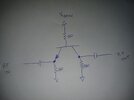i have a couple of cobra 148gtl (side mic) radios and i need to put a variable (carrier) power control in them. i have searched for hours and cannot find one online for some reason. thanks for the help
Last edited:
pic would be nice tooWe have been doing it so long I don't think we have a written record of the procedure. The parts you'll need are a 10k resistor, a 1N4148 generic small diode and 3 wires that will reach from the front-panel control to VR10 near the rear of the pc board. Best policy is to use the radio's SWR Cal control. Take the wires from the control and solder the wiper wire to the clockwise-lug wire. A 4.7k resistor now gets one side added to the two wires you just joined, the other end to the ground wire that came off the control's counterclockwise lug. This makes the SWR-meter circuit think the control is turned full clockwise. You may not care, but this keeps the SWR meter active. You just calibrate your SWR reading by setting the carrier level once the rest of the job is done.
Easiest way to set minimum carrier without adding a trimpot is to hijack the two tiny double-junction diodes D52 and D75 from alongside the 11.325 crystal. If the radio's clarifier has already been unlocked for sideband use, they aren't in the circuit anymore anyway. Remove these two diodes and lap-solder them in series. Now the end of these two with the paint dot (band) on the end gets soldered to a ground foil near to the carrier trimpot VR10. The unbanded end of the end-to-end pair goes to the outboard solder pad of VR10, the foil pad nearest the side rail.
The foil pad at the center pin (wiper) of VR10 gets severed. A wire from the VR10's center pin goes to the clockwise lug of the SWR cal control. A wire from the counterclockwise lug of the SWR cal goes to the outboard lug of VR10, where the diode got soldered. A wire from the wiper lug of the SWR Cal control long enough to reach VR10 is next. The far end of this wire gets lap soldered to the anode (not banded) end of the 1N4148. The banded end of this diode goes to the far end of the cut on the foil trace at VR10. The 10k resistor gets one end soldered to this same spot, the other end to a nearby ground foil.
The two diodes you soldered end-to-end and placed on one end of VR10 serve to make the minimum setting of the SWR Cal control a fairly stable 1/10 of a Watt more or less, but without adding a trimpot. If those two diodes were removed at some time in the past, a series string of four (yes four) generic 1N4148 diodes will do the same job, with only a little more effort. The original two teensy diodes were in fact "doubles" with two diodes in series inside each part.
Somebody (else) should probably put this up on a YT vid.
73
yes, agree. i had to pm him because the instructions are confusing. no reply yetpic would be nice too
the board is a PC-412ADWhat board marking, or link me schematic to that Cobra to cbtricks.
Mike


The Cb tricks web site is not available....Account Suspended.What board marking, or link me schematic to that Cobra to cbtricks.
Mike
